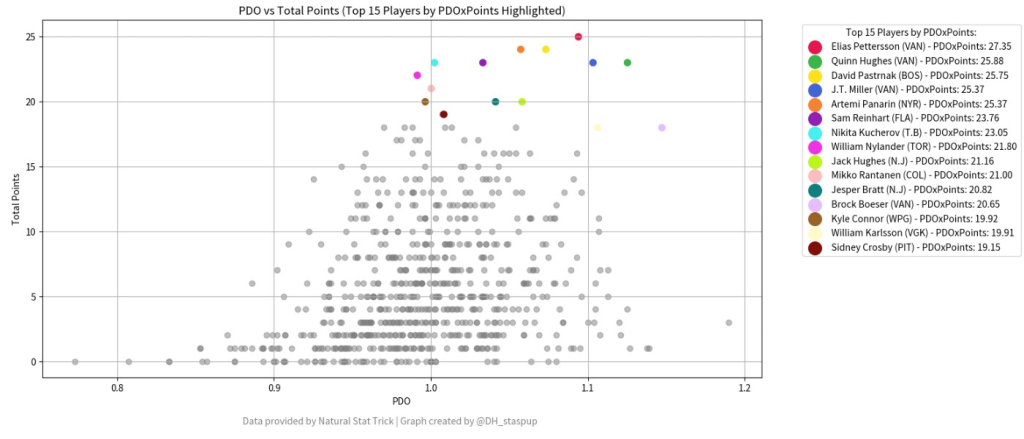PDO is a key metric for evaluating player performance and is often used to measure luck or variance. While PDO can regress towards a league average, suggesting predictability, its interpretation requires caution. A high or low PDO doesn’t always signify luck; it can also reflect team strategy or player skill. This article aims to demystify PDO, examining how it impacts player performance and fantasy value, while also highlighting its limitations as a predictive tool. We will analyze PDO in the context of fantasy hockey, providing insights into how it can both inform and mislead player evaluations.
Understanding PDO
PDO is a relatively simple yet insightful metric in the realm of hockey analytics. It is calculated as the sum of a team’s shooting percentage (the percentage of shots that result in goals) and save percentage (the percentage of shots against that are saved by the goalie). The league average for PDO is typically around 100, as shooting and save percentages usually hover around certain established norms (usually around 8-9% for shooting and 91-92% for save percentages). The value of PDO lies in its tendency to revert to the mean. A team or player with a PDO significantly higher than 100 is often perceived as ‘lucky’, benefiting from unsustainable shooting efficiency or exceptional goaltending, and is likely to see a regression to the mean over time. Conversely, a PDO below 100 can indicate ‘unluckiness’, suggesting potential for improvement. However, the reliance on PDO as a sole predictor of performance can be misleading. A consistently high or low PDO might not just be about luck; it could also reflect a player’s skill, the team’s style of play, or systemic factors that influence shooting and save percentages. For instance, a team that prioritizes high-quality shots may sustain a higher shooting percentage, while an excellent goalie can consistently contribute to a higher save percentage. Understanding the nuances of PDO is crucial as it can help managers identify players who are performing above or below their expected levels, but it should be used in conjunction with other metrics to get a complete picture of a player’s performance and potential.
PDO and Goals
In the quest to unearth the driving forces behind a player’s scoring prowess, PDO combined with goals (PDOxGoals) emerges as a compelling metric. It encapsulates not only the player’s ability to score but also the team’s overall shooting efficiency and the support of goaltending. High figures in this domain may suggest that a player is riding the crest of a wave buoyed by team performance as much as individual skill.

Upon examining the PDO versus Goals scatter plot, we observe a spectrum of player performances. Those situated at the upper end of the PDO scale with a substantial goal tally are experiencing periods of heightened efficiency. However, such spikes warrant a cautious approach; what ascends sharply may also fall swiftly, as the law of averages catches up. Players in this zone are prime candidates for regression, and fantasy managers should be judicious in leveraging these statistics for long-term strategy.
PDO and Assists
Assists are often viewed as the lifeblood of a team’s offensive flow, and when intertwined with PDO (PDOxAssists), they paint a picture of a player’s involvement in plays leading to goals. This metric sheds light on those who might be benefitting from a period of collective team success, possibly skewing their assist numbers higher than what might be sustainable.

The scatter plot displaying PDO against Assists draws a line between consistent playmakers and those potentially overachieving due to circumstances. A high PDOxAssists value could signal an inflated assist rate, inflated by the team’s overall performance rather than individual merit. Fantasy managers would do well to analyze such players in the context of their teams, discerning the true source of their elevated numbers and anticipating adjustments as the season unfolds.
PDO and Total Points
Combining PDO with Total Points offers a comprehensive overview of a player’s overall impact on the ice. PDOxPoints allows us to identify those who are not only scoring and assisting but also riding the high tide of team performance metrics. It’s a robust indicator of a player’s all-around contribution, yet one that must be interpreted with an eye toward the inevitable ebb and flow of a season.

The PDO versus Total Points scatter plot emphasizes those who lead the pack in overall impact. The players highlighted here are enjoying prolific phases, bolstered by both their goal-scoring and playmaking abilities. However, those with an extraordinary PDOxPoints may soon encounter the regression inherent in the game. It’s a reminder to fantasy managers that today’s stars, shining under the spotlight of favorable percentages, may not twinkle as brightly when the season’s tides change.
The Strategic Application of PDO in Fantasy Hockey
Our analysis reveals the dual nature of PDO as both an indicator of potential and a warning signal. By correlating PDO with goals, assists, and total points, we’ve identified patterns that can inform fantasy hockey strategies. While a high PDO often flags players likely to regress, a low PDO may pinpoint those set for a rebound. In essence, PDO should be one of several tools in a fantasy manager’s arsenal, used to assess player value with a critical eye. The key to leveraging PDO effectively lies in interpreting it alongside other performance indicators, ensuring a well-rounded approach to player evaluation and selection.
*Data courtesy of Natural Stat Trick | Graphs by @DH_staspup





 EDM
EDM FLA
FLA MIN
MIN NYR
NYR DAL
DAL L.A
L.A UTA
UTA CBJ
CBJ DET
DET VAN
VAN
